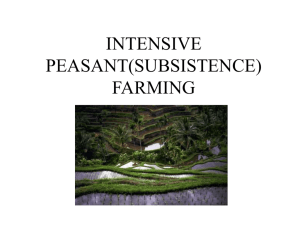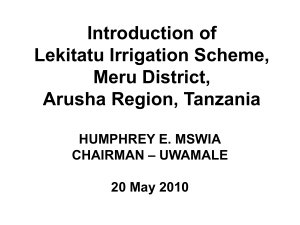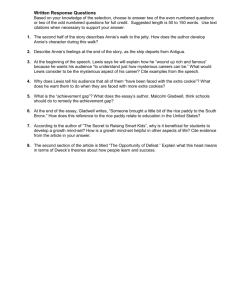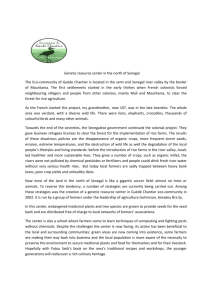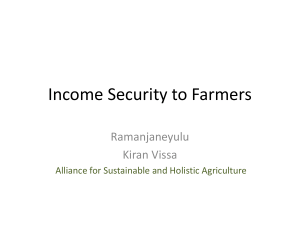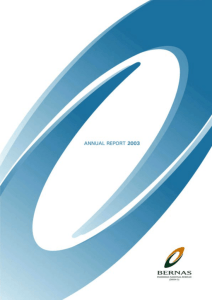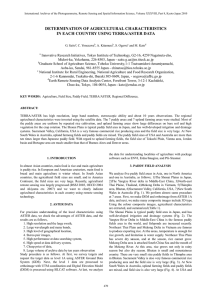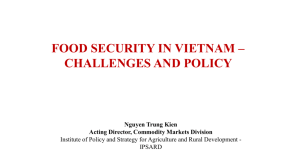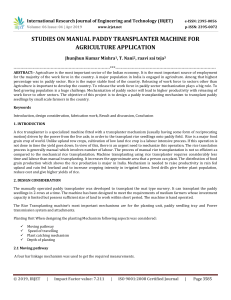INTENSIVE PEASANT(SUBSISTENCE) FARMING
advertisement
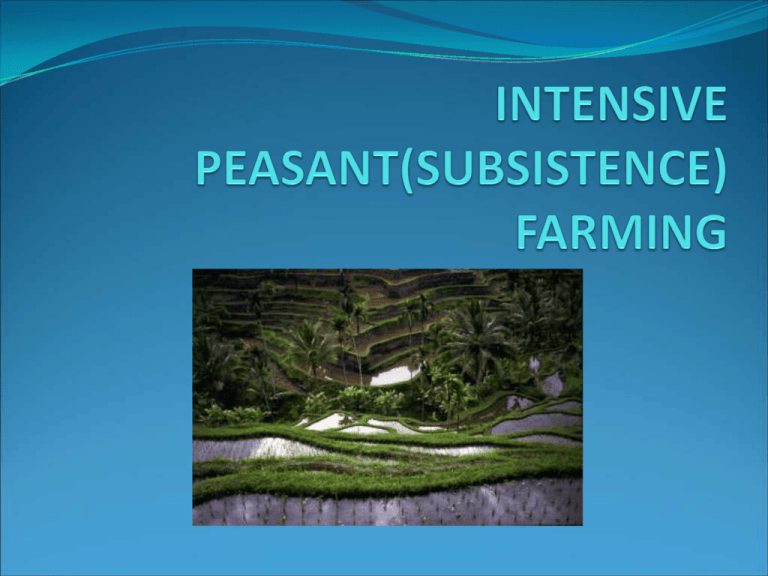
Wet Rice Farming Where ? South and East Asia ( Malaysia , Indonesia and SE China) Tropical /Equatorial climates All year round growing season. Temperatures greater than 20 C. Irrigation ( from rivers and rain storage ). Often 2 /3 crops of rice each year. Fields are flooded and known as paddy fields. On steep slopes terraces are made. Paddy fields are often stocked with fish. The Process Fields separated by bunds (banks of earth) Rice seeds planted , by hand,in nursery beds. Washing used seed trays Fields are flooded. Paddy fields are ploughed by oxen or water buffalo. Seedlings are transplanted into fields. Water level kept even by irrigation channels. Natural fertilisers added (manure or guano). Harvesting by hand( knives or sickles). Stubble left in ground to add nutrients to soil Rice plants ‘threshed’ to produce rice. Rice left out to dry. The Landscape Paddy fields (sometimes on terraces) surrounded by bunds. Villages are often long and linear along raised banks of rivers or along roads. Some small villages are found in the middle of rice fields. Paddy fields are often surrounded by irrigation channels. RECAP ! Fields separated by bunds. Seeds planted in nurseries. Fields flooded then ploughed (by animals). Seedlings planted into paddy fields. Natural fertilisers added. Harvested by hand. Stubble left in ground. Plants ‘threshed’. Rice dried out. The “Green Revolution” What was the Green Revolution? EMDCs helping ELDCs in the 1960s who were struggling with famine, such as India. Special High Yield Variety (HYV) seeds were given to ELDCs so that they could increase food production. Irrigation channels were constructed to provide fields with water all year round. An upper limit on land ownership was made, and all surplus land left over from large farms was divided between landless farm labourers. Farmers were encouraged to invest in machinery. Changes in production Increase in production in many areas. Change in production from subsistence to commercial agriculture. Use of high yielding varieties (HYV) of rice ,allowing crops 2 /3 times a year. Decline in fish ‘farmed’ in paddy fields. Increased use of chemical fertilisers and pesticides. Use of motorised ploughs instead of animals. Increased use of water storage tanks for irrigation. CONSEQUENCES Many farmers have become wealthy from the change to commercial agriculture. Mechanisation has led to decrease in labour required. This has led to landless workers becoming worse off and to migration from rural areas. Farmers have to spend much of their income on chemicals. Increase in wealth has led to increase in purchase of ‘consumer items and subsequently to increase in need for electricity. Use of chemical fertilisers and pesticides Ploughing by machines What was successful about the Green Revolution? India produced enough crops to feed the country and had some left over, so they started exporting to other countries. Crops grew more quickly and were irrigated so there were two harvest per year. Irrigation channels provide water to fields in the long term too. Landless farmers now owned some land to feed their own families. What was unsuccessful about the Green Revolution? Often this help was only short term. Jobs were lost due to the investment in machinery. Farmers couldn’t afford to buy the fertiliser that the new HYV crops needed from EMDCs. Farmers were unable to maintain or buy fuel for the machinery. Watch and take notes… https://www.youtube.com/watch?v=HucS CNQ01X4 Terraces Bund Village Paddy Fields Fruit trees Harvesting by hand Paddy Fields bunds Irrigation channels Planting seedlings 2004 ,Q6 Choose one of the traditional farming systems shown on the map .Referring to a named area where this type of farming is carried out,assess the impact which recent changes have had on the people, their way of life and the farming landscape. (6) 1996,Q6 a) Describe the traditional methods of rice production in south and East Asia. (4) b) Describe the changes in rice production in these Asian countries and suggest reasons for the change. (5)
